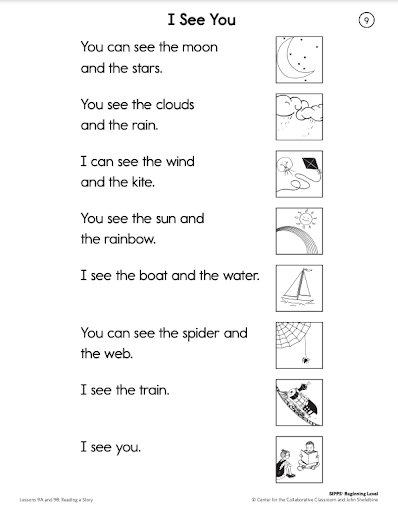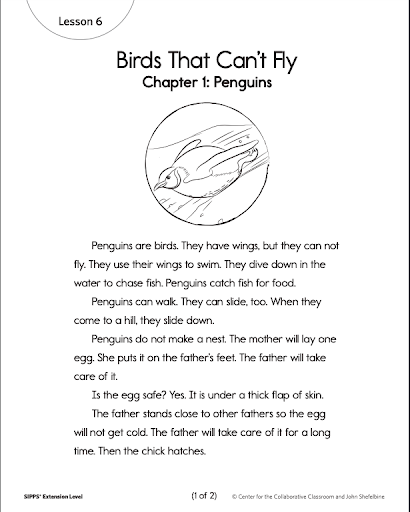In the white paper “Effective Decodable Text: When, What, and Where It Takes the Reader” by Dr. Katherine Newman, she explores the characteristics of decodable text and explains how the use of such text is essential to the development of word recognition skills.
In this companion blog post, we unpack the reasons why it is necessary to include decodable text as part of comprehensive reading instruction.
Why Decodable Text?
Remember the old phrase “practice makes perfect”? When we set our minds to learning something new, whether it be how to ride a bike, bake a new dessert, or play an instrument, we expect practice to be part of the process.
Ample practice is a universal essential in order for new learning to stick or the new skill to be mastered.
Specific to reading foundational skills, practice with discrete skills in isolation is necessary, as is practice with connected text.
Connected text is characterized by having multiple sentences that are related to each other. When the words in that text have been carefully selected based on spelling-sound correspondences, the connected text is also considered decodable.
Connected text is characterized by having multiple sentences that are related to each other. When the words in that text have been carefully selected based on spelling-sound correspondences, the connected text is also considered decodable.
Reading connected, decodable text engages students in the application of skills more so than does practicing skills in isolation, particularly when the text includes decodable words that are aligned to the word recognition skills they are learning.
Practicing these newly taught developing reading skills leads to mastery of word recognition skills. This in turn brings students closer to the ultimate goal of reading instruction: being able to read with high levels of accuracy and automaticity as well as understanding.
The body of research referred to as the Science of Reading also emphasizes student mastery of word recognition skills. The solidification of these skills requires vast amounts of practice and application.
Decodable text provides an accountable way to ensure students practice by reading connected text that includes spelling-sounds and high-frequency words they have previously learned in isolation.
Decodable text provides an accountable way to ensure students practice by reading connected text that includes spelling-sounds and high-frequency words they have previously learned in isolation.

A Continuum of Text Types for Reading Practice
Just as there is a continuum for development in foundational skills, there is a continuum of the types of texts that are most supportive of students as they reach specific reading milestones.
These texts serve as temporary scaffolds to provide the reader with a level of support based on the skills they have been introduced to.
As Dr. Newman says in her white paper, “Decodable text is not beneficial at all stages of learning to read, but at particular stages.”
For example, students in the spelling-pattern phase who have mastered spelling-sounds for short vowels, frequently occurring consonants, and a bank of high-frequency words should practice applying these patterns in isolation (sound level, word level) as well as in connected, decodable text.
Also important to note is that decodable text should not be used exclusively. Students must have access to a wide variety of texts at different phases of their reading development, in addition to decodable text.
As Dr. Newman says in her white paper, “Decodable text is not beneficial at all stages of learning to read, but at particular stages.”
Let’s take a look at some different types of text and when they should be used along the continuum.
Predictable Texts
Located at the start of the continuum are predictable texts. This text type is characterized by simple, patterned sentences and pictures to support word identification.
Predictable texts have a brief use in reading instruction at the point when students know letter names but not many sounds. Predictable texts provide beginning readers with connected text through which they can practice high-frequency words until they have learned enough letter sounds to blend words.
Once students are able to blend, predictable text is no longer needed.

Decodable Texts
Further along the continuum, as students gain mastery of enough spelling-sounds to be able to blend words, they benefit from decodable texts that contain words linked to the phonics instruction they are receiving—previously taught spelling-sound relationships, spelling patterns, and high-frequency words.
The careful connection between instruction and practice is intended to ensure students are able to apply the skills they learned in isolation during independent reading.
The careful connection between instruction and practice is intended to ensure students are able to apply the skills they learned in isolation during independent reading.

Transitional Texts
Even further along the continuum, when students have mastery of most spelling-sound patterns and high-frequency words and are learning strategies for decoding multisyllabic words, they need transitional texts.
Instructionally, in this phase, students are learning that decoding a word from left to right is no longer their only strategy. Transitional texts provide students with the opportunity to practice and apply their growing body of problem-solving strategies to flexibly read unfamiliar words—and especially consider how certain word parts or syllables impact decoding.
Examples of transitional texts include easy-to-read trade books and books that discuss high-interest topics at lower readability levels.
Examples of transitional texts include easy-to-read trade books and books that discuss high-interest topics at lower readability levels.
These books are intended for use with students who have a foundation of word recognition skills and are ready to apply those skills in text that is more authentic and uses natural language patterns, but isn’t so difficult that it causes frustration for students.
When reading transitional texts, students orchestrate both word recognition and language comprehension skills as they read and make sense of text.

As Readers Develop, Texts Should Change
Enormous amounts of reading provide the practice needed for students to become accurate and automatic readers.
Immediate access to text helps students develop a sense of themselves as readers, and helps them make the connection between the decoding practice that happens in isolation and reading connected text.
Decodable text that is aligned to the scope and sequence of instruction provides a scaffold for students.
Dr. Newman identifies this alignment as the “lesson-to-text match,” stating that “The lesson-to-text match is crucial. It relates to the major goals of decodable text: to help the reader achieve accuracy and automaticity.”
“The lesson-to-text match is crucial. It relates to the major goals of decodable text: to help the reader achieve accuracy and automaticity.”
—Dr. Katherine Newman, from her white paper
Like any scaffold, the goal is to use it only as long as it’s needed. Eventually, the learner is ready to remove the bike’s training wheels, bake without the recipe in hand, or play a new tune on the first try.
As students’ reading skills develop, the texts they practice in should also change. In other words, the scaffolds within the text should decrease.
As students’ reading skills develop, the texts they practice in should also change. In other words, the scaffolds within the text should decrease.
Transitional texts used for practice should be increasingly complex. Students’ reading diets at this phase should include wide reading of various topics that afford them the opportunity for flexible application of skills.
Comprehensive reading instruction that affords students time to practice reading a wide variety of texts is essential to ensuring students become accurate and automatic readers.
***
Learn more about this topic
Download the white paper by Dr. Katherine Newman: Effective Decodable Text: When, What, and Where It Takes the Reader.
Related blog: Four Common Misconceptions About the Science of Reading
***
Learn more about our programs
Learn about Collaborative Classroom’s libraries: Individualized Daily Reading Essential Collection and Fluency Practice Libraries
Learn about K–12 reading intervention: SIPPS®
Learn about K–5 comprehensive reading instruction: Being a Reader™
